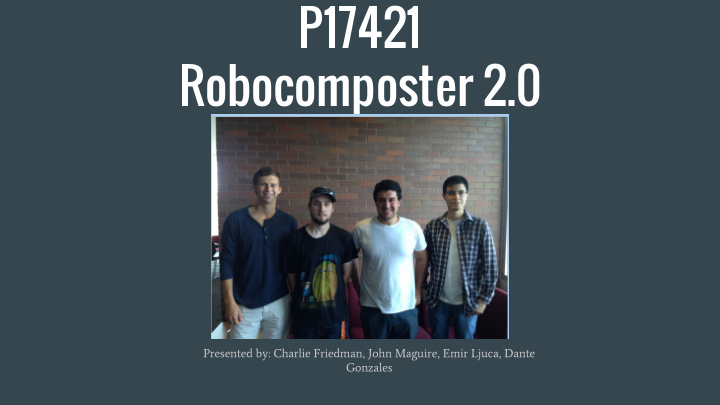



P17421 Robocomposter 2.0 Presented by: Charlie Friedman, John Maguire, Emir Ljuca, Dante Gonzales
Project Background Composting is a sustainable form of breaking down ● organic waste to lush fertilizer Concept initiated by a student at the Montessori School ● and then funded by Rochester Roots RoboCompostor 1.0 developed most of the hardware ● Lacks testing, key controls, and verification of ○ functionability
Problem Statement Build on the prototype platform to deliver a sound mechanical platform that has ● been thoroughly tested ○ Conduct a plethora of testing on composting time, grinder, and augers Add controls and automation to the mechanical platform ● Deliver a platform that is educational and intuitive ● Deliver a safe device ●
Project Deliverable A fully operable composting platform will be refined ● Will include intuitive controls, intuitive exporting capabilities, visual display of pH, temperature, ○ and humidity readings Data confirming successful operating performance metrics with a composting ● goal of 2 weeks A robust user manual ● All relevant drawings and schematics ●
Use Case Scenario (Loading Compost)
Use Case Scenario (Data Handling)
Use Case Scenario (Unloading Compost)
Customer Requirements
Engineering Requirements
House of Quality
Benchmark Composting Methods Cold Composting ● Pile / Windrow Composting ○ Pit / Trench Composting ○ Vermicomposting (Worms) ○ Hot Composting ● ○ In-Vessel Composting small scale In-Vessel Composting industrial scale ○ ○ Closed Bin (Anaerobic) Composting
Risk Assessment Types of Risk Technical ● Part failure, Lack of technical knowledge, Faulty assumptions ○ Resource ● ○ Schedule conflict, Budget, Accessibility Safety ● Injury, Stability ○ Environment ● Hazardous materials and gases ○ Social ● Design choices ○
Questions?
Recommend
More recommend